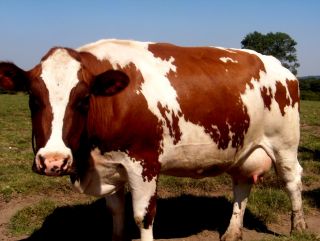Type the name of the breed you're looking for below
[wpdreams_ajaxsearchlite] Don't see the breed your're looking for? Click here and let us know!
Meuse-Rhine-Yssel Cattle
| Place of Origin | Netherlands |
| Origin | HistoryThe Meuse Rhine Issel originates from the Netherlands and Germany. In the Netherlands, it was developed in the region of the three rivers from which it gets its name. In Germany it comes from the regions of Westfalia, Rhineland and Schleswig Holstein, and is known there as the Rotbunt. Photo courtesy of Dairy Dreams, www.dairydreams.co.uk The last part of their name is sometimes spelled "Yssel" or "Ijssel". The Meuse Rhine Issel is also known as Rotbunt, Roodbont, Maas-Rijn-Yssel, Rotbunte holländische, Mosane-rhénane-ysseloise, Dutch Red-and-White, Red Pied Dutch, MRI and MRY. In 1874 the Dutch herdbook was formed and the German breed societies followed in 1900. They were run as one breeding area across the border until 1914. During the 1920's, the Dutch bull called Sjoerd 1 925 was used extensively in the Rhineland area and played a large part in establishing a good MRI type there. Between 1920 and 1950, Belgium, Luxembourg, France and Denmark founded their own Red and White Dual Purpose breeds, based on the Dutch and German stock. The breed in its early years was bred as a dual purpose animal for beef and dairy, but recently breeders have concentrated on its dairy qualities although the beef is still excellent MRI cattle were first imported into the UK and Ireland in the early 1970's and have increased in numbers to around 31,500 today. Current milk pricing structures ensure a huge demand for this extremely profitable breed, where yields of 8000 to 9000kgs at 4.0% protein are not uncommon. |
| Purpose | It is a dual purpose breed, both milk and meat production. Producers have now concentrated on their milk production and the breed now comprises over a quarter of the Dutch cattle population. |
| Appearance | Females are about 135 cm in height. Males stand 142 cm. Meuse Rhine Issel are medium sized breed with a solid build, they are red and white in colour with good length and depth to the body. |
| Horns | Naturally polled (hornless) |
| Cows Average Weight | 900 kg. (1,984 lbs.) |
| Bulls Average Weight | 1,200 kg (2,200 lbs.) |
| Other Considerations | They are an adaptable hardy breed and have good disease resistance, they perform well on rough pasture. They are very docile in temperament, the cows have a relatively short gestation period and calve easily. |



